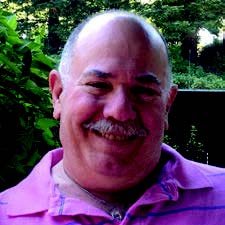 On January 23, 1849, Jason Chamberlain, a 27-year-old carpenter, and James Chaffee, 25, a wheelwright, boarded the ship Capitol at anchor in Boston Harbor. They had met and become dear friends in Worcester, Massachusetts, in 1846. Now the two bachelors joined some 250 other men–and two women, both married–for a voyage of more than 15,000 miles around Cape Horn to San Francisco and the gold fields of the Sierras. They remained in California–and remained a couple–for the next 54 years.
On January 23, 1849, Jason Chamberlain, a 27-year-old carpenter, and James Chaffee, 25, a wheelwright, boarded the ship Capitol at anchor in Boston Harbor. They had met and become dear friends in Worcester, Massachusetts, in 1846. Now the two bachelors joined some 250 other men–and two women, both married–for a voyage of more than 15,000 miles around Cape Horn to San Francisco and the gold fields of the Sierras. They remained in California–and remained a couple–for the next 54 years.
Their journey around Cape Horn took 162 days, including stops at Rio de Janeiro and Valparaiso. They arrived on July 20, “in such a dense fog that we cannot see a mile from us,” the captain noted in his ship’s log. There were “hearty cheers” when “that old mud hook went down” into the waters of the bay, he wrote, adding, “May God deliver us from having to make the ocean our home so long again.” For many of his passengers, however, their adventure was just beginning.
The Argonauts entered a city of men, “by not a few looked upon as a Sodom of wickedness,” according to the Alta California. It was a place, one visitor wrote, “lit by the glare of its hells.” More than 90% of the residents were men. Ladies, usually married, were so few that to see one “walking along the streets of San Francisco was more of a sight than an elephant or giraffe would be today.” There were somewhat more women–as opposed to ladies–but they were expensive. Most of the men found companionship with each other.
Chamberlain and Chaffee carried their worldly possessions onto one of the sand hills of Happy Valley, a few hundred feet from the site of today’s Palace Hotel, where they pitched their tent. Both quickly found work, earning $16.00 a day. In a short time, however, the lure of great fortune in the Sierra foothills became too compelling, and they left for the gold fields of Calaveras County.
Their luck was good for a while, but they never did unearth Solomon’s gold mine. Eventually they settled at Second Garrotte in Toulumne County. They built a house, meant to last a hundred years (which it did), took up farming, grew vegetables, cultivated apples, and manufactured cider and vinegar. In time they opened a way station for visitors traveling to the Yosemite Valley. Except for those few occasions when Chaffe, ever hopeful, went off prospecting, the two men were together every day for the rest of their lives.
Chamberlain and Chaffe embodied the archetype of the ‘49ers described by Hubert Howe Bancroft in volume XXIII of his History of California, published in 1888. “Sacred like the marriage bonds,” he wrote of the prospectors, “were the ties which oft united united men …, yoking them together.” These “unions of two,” he added, presented “the heroic possibilities of a Damon or Patroclus.” Few of his readers, educated in the classics, would have missed his allusion to two of the ancient world’s most famous same-sex couples.
Friends and neighbors, who saw the same special relationship between the men, considered them a couple in every way. Theirs was the only double biography in the History of Toulumne County, published in 1882, which described them as “an example of life-long friendship between men, that is as interesting as it is rare.” Since their arrival in California, the author explained, “they have never since been separated.” Twenty years later the Illustrated History of Toulumne County (1901) pronounced them “bosom companions and partners.” They were “the first citizens of Second Garrote.”
Were they intimate in all ways? Some of their guests thought so. “The artistic inclination of these gentlemen,” one wrote in their guestbook, using a code term for lovers of their own gender, “is quite apparent, though which one is the ‘ladies man’ we could not discover, each modestly declining the honor.” Another commented upon “the wedded bachelors” and a third upon their “attachment to each other,” which “has the true ‘Damon and Pythias’ ring.” To another, they were “men after my own Heart.”
Given the spirit of the age and its reticence to discuss all things sexual, determining after more than a century who were couples in every sense is difficult. Even those who sought same-sex unions did not necessarily have them with the men they lived with. Whether sexual or not, Chamberlain and Chaffe had a deep and loving relationship.
Chaffee died in July 1903. Chamberlain, by himself for the first time in more than half a century, could not be comforted. “As to being alone,” he wrote to an old friend, “there is none that can fill the place left vacant by Chaffee.” After six weeks without him, he chose to join his partner in eternity. They had been together, inseparable, for 57 years.
Bill Lipsky, Ph.D., author of “Gay and Lesbian San Francisco” (2006), is a member of the Rainbow Honor Walk board of directors.
Recent Comments